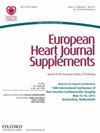Efficacy of cryoablation in atrial fibrillation: comparison with antiarrhythmic therapy
IF 1.7
4区 医学
Q3 CARDIAC & CARDIOVASCULAR SYSTEMS
引用次数: 0
Abstract
Atrial fibrillation (AF) represents the most common arrhythmia in clinical practice, characterized by irregular atrial electrical activity originating mainly in and around the pulmonary veins. This condition can manifest itself symptomatically or silently but still dangerously. Complications associated with AF include stroke, heart failure, worst clinical outcome in patients with underlying conditions, increased emergency room visits, hospitalizations, and cardiovascular mortality. Currently, according to the main international guidelines, antiarrhythmic therapy is considered the first choice for rhythm control in patients with AF despite modest efficacy and non-negligible side effects. In recent decades, radiofrequency catheter ablation has emerged as an alternative to antiarrhythmic drugs for rhythm control. Cryoablation was developed with the aim of reducing procedural times and reducing complications related to the ablative procedure with radiofrequency without losing efficacy. Recent studies conducted with rigour and scientific solidity have demonstrated on the one hand that the results of this technique are not inferior compare with radiofrequency. This study aims to compare data on the safety and efficacy of cryoablation with those obtained from antiarrhythmic drugs through a review of the most recent scientific evidence.低温消融术治疗心房颤动的疗效:与抗心律失常疗法的比较
心房颤动(房颤)是临床上最常见的心律失常,其特点是主要起源于肺静脉及其周围的不规则心房电活动。这种情况可以表现为无症状或无声无息,但仍然很危险。与房颤相关的并发症包括中风、心力衰竭、有基础疾病的患者临床预后最差、急诊就诊率增加、住院率增加以及心血管死亡率增加。目前,根据主要的国际指南,抗心律失常治疗被认为是心房颤动患者控制心律的首选,尽管疗效一般,副作用也不可忽视。近几十年来,射频导管消融术已成为抗心律失常药物控制心律的替代疗法。冷冻消融术的开发旨在缩短手术时间,减少射频消融术的相关并发症,同时不降低疗效。最近进行的严谨而科学的研究一方面证明了这项技术的效果并不逊色于射频消融。本研究旨在通过回顾最新的科学证据,比较冷冻消融与抗心律失常药物的安全性和有效性。
本文章由计算机程序翻译,如有差异,请以英文原文为准。
求助全文
约1分钟内获得全文
求助全文
来源期刊

European Heart Journal Supplements
医学-心血管系统
CiteScore
3.00
自引率
0.00%
发文量
575
审稿时长
12 months
期刊介绍:
The European Heart Journal Supplements (EHJs) is a long standing member of the ESC Journal Family that serves as a publication medium for supplemental issues of the flagship European Heart Journal. Traditionally EHJs published a broad range of articles from symposia to special issues on specific topics of interest.
The Editor-in-Chief, Professor Roberto Ferrari, together with his team of eminent Associate Editors: Professor Francisco Fernández-Avilés, Professors Jeroen Bax, Michael Böhm, Frank Ruschitzka, and Thomas Lüscher from the European Heart Journal, has implemented a change of focus for the journal. This entirely refreshed version of the European Heart Journal Supplements now bears the subtitle the Heart of the Matter to give recognition to the focus the journal now has.
The EHJs – the Heart of the Matter intends to offer a dedicated, scientific space for the ESC, Institutions, National and Affiliate Societies, Associations, Working Groups and Councils to disseminate their important successes globally.
 求助内容:
求助内容: 应助结果提醒方式:
应助结果提醒方式:


